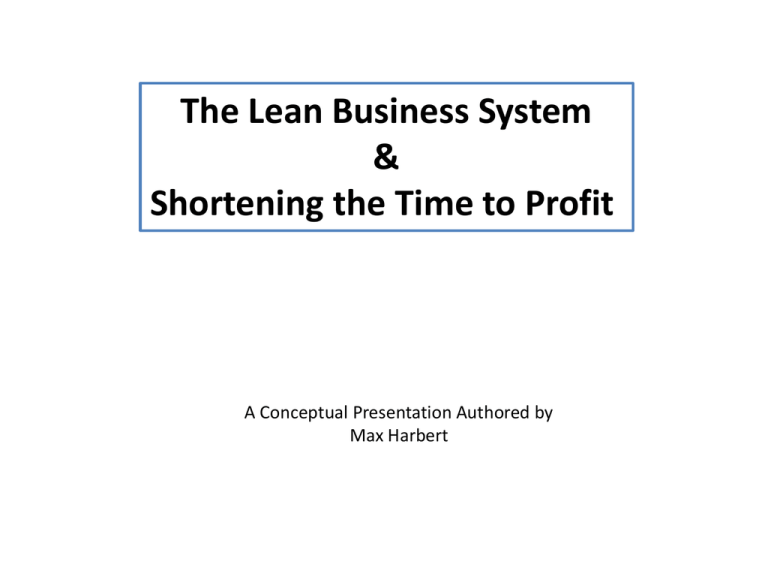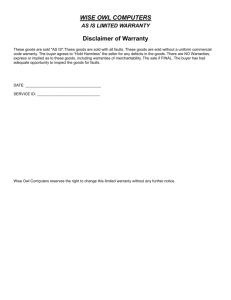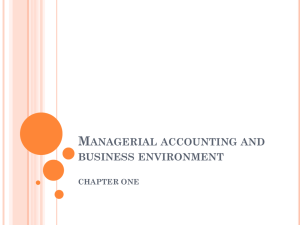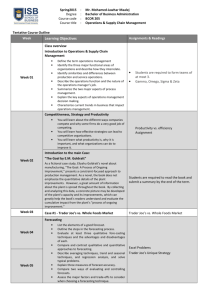Simple business time lines
advertisement

The Lean Business System & Shortening the Time to Profit A Conceptual Presentation Authored by Max Harbert Vision of Lean Business Model “All we are doing is looking at the time line from the moment the customer gives us an order to the point when we collect the cash. And we are reducing that time line by removing the non-value added wastes” -Taichi Ohno Easy!. . . Right? Ohno Model Time Line Order Cash Time Vision of Lean Business Model Ohno’s model is simple and easy to understand, but it does not communicate all things necessary for collecting cash, and making a profit. Let’s add some detail, and establish the idea of a Standard Business Timeline. Standard Business Time Line Inventory typically accumulates as a function of economies of scale, and customer order size. This type of thinking consumes working capital and contributes to the creation of business cycles and economic bubbles. First, Let’s establish the duration of the business timeline as the time between the business decision to satisfy a market demand, (t=0) and the time that the business earns a profit. Inventory t=0 Order Product Development Manufacturing Second, Let’s establish the activities that fundamentally create value that the customer is willing to pay for: Product Development, Manufacturing, Distribution, Warranty Third, Lets Identify the bilateral communication events between a business and its customers after t=0, Order, Delivery, Cash (payment), and Warranty (But we really don’t want to hear from our customers during warranty) Distribution Delivery Cash Warranty Orders can be placed at any time between t=0 and delivery. Some businesses can collect cash prior to delivery, or at the point of sale, Traditionally payment is made in the month after receipt of goods. Notice that Profit is not recognized in this model until all business liabilities for the product have expired (think Volkswagon) t=profit Vision of Lean Business Model Lean businesses Strive to produce one piece flow at the time and rate of customer consumption. Standard Business Time Line ADJUSTING FOR JUST IN TIME (JIT) When batch Manufacturing transitions to JIT a part is made for every part delivered This has a net effect of shortening lead time and the time required to make real profit Inventory t=0 Order Delivery Cash t=profit Inventory Product Development Manufacturing Orders Distribution JIT Reduces inventory decreasing working capital, increasing ROI, and Free Cash Flow Delivery Warranty $$ Cash $$ Warranty $$ Profit $$ Vision of Lean Business Model JIT Time Line Progressing to the Lean Business Model t=0 • As the Lean Business model progresses to ideal state, products are developed and refined on Inventory shorter cycles. Inventory • This is a direct result of the Orders Product Development weaving effect the Lean model creates between customers and Manufacturing suppliers. (Foundation for PDCA The manufacturing block can be Loop. replaced with services, or Distribution • The Lean model creates high processes and Inventory becomes frequency interactions, and work in process when adapting the codependency, further reducing modelDelivery to service organizations. the time to profit. • The Batch environment creates Warranty Warranty point interactions, hostile for price, and $$ Profitbargaining, $$ $$ Cash $$ adversarial relations regarding warranty service. Dt=takt time • The Lean Model maximizes wealth through strict monitoring of margin, volume, velocity, and customer feedback. t=profit Vision of Lean Business Model Additional Leverage t=0 t=profit Inventory Product Development • Feedback from the customer drives relentless improvements to quality building brand equity. • As Brand equity increases, Warranties can be tapered due to the strong reputation of product. • Time to profit is further reduced. Orders Manufacturing Distribution Delivery Warranty Warranty Warranty $$ Cash $$ $$ Profit $$ Dt=takt time Warranty



